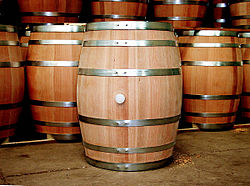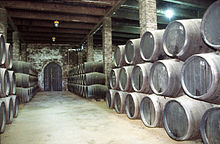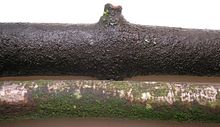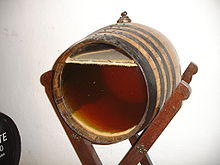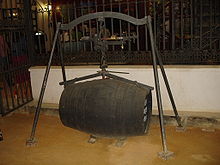- Barrel
-
 Modern stainless steel beer barrels—also called casks or kegs—outside the Castle Rock microbrewery in Nottingham, England
Modern stainless steel beer barrels—also called casks or kegs—outside the Castle Rock microbrewery in Nottingham, England
A barrel or cask is a hollow cylindrical container, traditionally made of vertical wooden staves and bound by wooden or metal hoops. Traditionally, the barrel was a standard size of measure referring to a set capacity or weight of a given commodity. A small barrel is called a keg.
For example, a beer barrel had originally a capacity of 36 US gallons (140 L) while an ale barrel a capacity of 32 US gallons (120 L). Wine was shipped in barrels of 31.5 US gallons (119 L).
Modern wooden barrels for wine-making are either made of French common (Quercus robur) and white oak (Quercus petraea) or from American white oak (Quercus alba) and have typically these standard sizes: "Bordeaux type" 59.4 US gallons (225 L) and "Cognac type" 79.2 US gallons (300 L).
Barrels are only one type of cooperage. Other types include, but are not limited to: buckets, tubs, butter churns, hogsheads, firkins, kegs, kilderkins, tierces, rundlets, puncheons, pipes, tuns, butts, pins, and breakers. Someone who makes barrels is called a "barrel maker" or cooper. Modern barrels and casks can also be made of aluminum, stainless steel, and different types of plastic, such as HDPE.
Barrels have a variety of uses, including storage of liquids such as water and oil, fermenting wine, arrack and sake, and maturing beverages such as wine, cognac, armagnac, sherry, port, whiskey and beer.Contents
History
The barrel was most likely invented in the Balkan area. Even though Herodotus mentions palm-wood casks used in shipping Armenian wine to Babylon in Mesopotamia, the barrel as we know it today was most likely developed by the Celts. The Celts arrived in the 23rd Century BCE in an area known today as the Burgundy - France, coming from the Balkans and regions north of the Danube River.
Around 350 B.C. they were already using watertight, barrel-shaped wooden recipients that were able to withstand stress and could be rolled and stacked. The name “tonneau” (also called “barrique”) comes the Latin “Dolium” which means rounded.The technique of bending wood into shape through heating they most likely borrowed from boat building, where it was used to bend planks for ship’s hulls as early as the ancient Egyptians and Phoenicians. The barrel, apart of serving as a recipient for wine and other liquids such as water, vinegar and oil, was also used for the storage and transport of precious metals, nails, powders, ocher and sulfur, as well as for the preservation of fish, olives, mustard and other sweet, salted or pickled foods.
In Asia and Europe, liquids like oil and wine were mostly carried in earthenware vessels. The Greeks and Romans kept their wines and other liquids in large vases called “Cadus” or Amphorae, sealed with pine resin.
The Romans began to use barrels in the 3rd century AD, as a result of their commercial and military contacts with the Gauls. That the Italian wines of the time were no competition for the nectar of the “Gaulois”, can not be more clearly illustrated than with a quote from Diodore[disambiguation needed
 ], a contemporary of Julius Caesar, who wrote: "The Italian merchants exploit the Gallic passion for wine. On the boats which follow the waterways or by wagons which roll across the plain, they transport wine, from which they make fantastic profits, going as far as trading one amphora for one slave, in such manner that the buyer brings his servant to pay for the drink."
], a contemporary of Julius Caesar, who wrote: "The Italian merchants exploit the Gallic passion for wine. On the boats which follow the waterways or by wagons which roll across the plain, they transport wine, from which they make fantastic profits, going as far as trading one amphora for one slave, in such manner that the buyer brings his servant to pay for the drink."Towards the end of the era of Augustus, the Allobroges of the Rhone valley had selected a vine species that was acclimatized to their region. This "Allobrogic" variety bore frost resistant grapes, thus pushing back the northern limits of vine cultivation by several hundreds of kilometers. At the same time, in the plains of Aquitaine, in the Gaillac region, another vine variety - "Biturica" - made the Bordeaux prosper.
The wines from the Gallic province were highly appreciated in Rome, and the progression of the vine worried the Romans to such an extent that, in 92 A.D., the emperor Domitien decided to destroy the Gallic vineyards. Around the same time, Pliny the Elder noted - in the regions near the Alps - the appearance of an exceptional recipient specially conceived to hold and mature wine: the wooden barrel, which became inseparably associated with wine, from its fermentation to its transport. Archaeological research has found cooper’s tools and wooden seals dating from as early as 100 B.C.
For nearly 2,000 years barrels were the most convenient form of shipping or storage container for those who could afford the superior price. All kinds of bulk goods, from nails to gold coins, were stored in them. Bags and most crates were cheaper, but they were not as sturdy and they were more difficult to manhandle for the same weight. Barrels for the transportation for bulk goods slowly lost their importance in the 20th century, with the introduction of pallet-based logistics and containerization, however, they are still of great importance in the elaboration of wines and spirits.
Starting in the late 19th century, barrels were largely superseded by corrugated fiberboard boxes for storage and transport of dry goods, and in the mid 20th century, steel drums began to be used for the storage and transport of fluids such as water, oils and hazardous waste.
Water storage
Water barrels are often used to collect the rainwater from dwellings (so that it may be used for irrigation or other purposes). This usage, known as rainwater harvesting, requires (besides a large rainwater barrel or water butt), adequate (water-proof) roof-covering and an adequate rain pipe.
Oil storage
 Standard Oil Company blue 55-US gallon (46 imp. gal, 208 L) barrel (drum)
Standard Oil Company blue 55-US gallon (46 imp. gal, 208 L) barrel (drum)
The standard barrel of crude oil or other petroleum product (abbreviated bbl) is 42 US gallons (34.9723 imp gal; 158.9873 L). This measurement originated in the early Pennsylvania oil fields, and permitted both British and American merchants to refer to the same unit, based on the old English wine measure, the tierce.
Earlier, another size of whiskey barrel was the most common size; this was the 40 US gallons (33.3 imp gal; 151.4 L) barrel for proof spirits, which was of the same volume as 5 US bushels. However, by 1866 the oil barrel was standardized at 42 US gallons.
Oil has not actually been shipped in barrels[1] since the introduction of oil tankers, but the 42-US-gallon size is still used as a unit for measurement, pricing, and in tax and regulatory codes. Each barrel is refined into about 19.74 US gallons (16.44 imp gal; 74.7 L) of gasoline,[2] the rest becoming other products such as jet fuel and heating oil, using fractional distillation.[3]
The current standard volume for barrels for chemicals and food is 55 US gallons (46 imp gal; 208 L).
Beverage maturing
An "aging barrel" is used to age wine; distilled spirits such as whiskey, brandy, or rum; Tabasco sauce; or (in smaller sizes) traditional balsamic vinegar. When a wine or spirit ages in a barrel, small amounts of oxygen are introduced as the barrel lets some air in (compare to microoxygenation where oxygen is deliberately added). Oxygen enters a barrel when water or alcohol is lost due to evaporation, a portion known as the "angels' share". In an environment with 100% relative humidity, very little water evaporates and so most of the loss is alcohol, a useful trick if one has a wine with very high proof. Most beverages are topped up from other barrels to prevent significant oxidation, although others such as vin jaune are not.
Beverages aged in wooden barrels takes on some of the compounds in the barrel, such as vanillin and wood tannins. The presence of these compounds is dependent on many factors, including the place of origin, how the staves were cut and dried, and degree of "toast" applied during manufacture. After roughly three years, most of a barrel's flavor compounds have been leached out and it is well on its way to becoming "neutral." Barrels used for aging are typically made of French or American oak, but chestnut and redwood are also used. Some Asian traditions (e.g. Japanese sake) have been known to use Japanese cedar, which imparts an unusual, minty/piney flavor. In Peru and Chile, a grape distillate named "Pisco" is either aged on oak or in earthenware, in which case the minerals from the fired clay leach into the liquor, giving it a unique flavor.
Beers are sometimes aged in barrels which were previously used for maturing wines or spirits.
Wine
Some wines are fermented "on barrel," as opposed to in a neutral container such as a steel or wine-grade HDPE (High density polyethylene). Wine can also be fermented in large wooden tanks, which - when open to the atmosphere - are called "open-tops". Other wooden cooperage for storing wine or spirits range from smaller barriques to huge casks, with either elliptical or round heads.
The tastes yielded by French and American species of oak are slightly different, with French oak being subtler, while American oak gives stronger aromas.[4] To retain the desired measure of oak influence, a winery will replace a certain percentage of its barrels every year, although this can vary from 5 to 100%. Some winemakers use 200% new oak, where the wine is put into new oak barrels twice during the aging process. Bulk wines are sometimes flavored by soaking oak chips in them instead of barrel aging.
Whiskey
Laws in several jurisdictions require that whiskey be aged in wooden barrels.
The law in the United States requires "straight" whiskey (with the exception of corn whiskey) must be stored for at least 2 years in oak containers,[5] and that Bourbon (in specific) must be aged in new, charred oak barrels as one of several necessary conditions which have to be met before the whiskey can be labeled as a bourbon whiskey.
International laws require any whisky bearing the label "Scotch" to be distilled in Scotland and matured for a minimum of three years and one day in oak casks.[6]
By Canadian law,[7] Canadian whiskies must "be aged in small wood for not less than 3 years".
Sherry
The sherry is stored in 600-litre casks that are made of North American oak, which is slightly more porous than French or Spanish oak. The casks, or butts, are filled five-sixths full, leaving "the space of two fists" empty at the top to allow flor to develop on top of the wine.
Brandy
Maturing is very important for a good brandy, which is typically aged in oak casks. The used wood for those barrels is selected because of its ability to transfer certain aromas to the spirit. Cognac only ages in oak casks made from wood from the Tronçais and more often from the Limousin forests.[8]
Balsamic vinegar
Traditional balsamic vinegar is aged in a series of wooden barrels.
Tabasco sauce
Since its invention in 1868, the pepper mash used to make Tabasco sauce is aged for three years in previously-used oak whiskey barrels.
"Angels' share" is a term for the portion (share) of a wine or distilled spirit's volume that is lost to evaporation during aging in oak barrels. The barrels are typically French or American oak. In low humidity conditions, the loss to evaporation may be primarily water. However, in higher humidities, more alcohol than water will evaporate, therefore reducing the alcoholic strength of the product. In humid climates, this loss of ethanol is associated with the growth of a darkly colored fungus, the Angels' Share fungus, Baudoinia compniacensis, on the exterior surfaces of buildings, trees and other vegetation, and anything else that happens to be nearby.[9]
Other uses
Due to the traditional barrel's distinctive shape and construction method, the term has been used to describe a variety of other related or similar objects, such as the gun barrel (with the term growing out of the fact that early cannon were built from staves of metal hooped together, similar to a barrel)[10] and barrel organ.
The English idiom over a barrel means to be in a predicament or helpless in a situation where others are in control: "I have no choice in the matter — my creditors have me over a barrel." The phrase is said to originate from two 19th century practices: rolling drowning victims over a barrel to clear their lungs of water, or flogging someone who is bent over a barrel.
Some kinds of food, such as pork, were stored in barrels in larders before the era of refrigerators. This practice generated a political term, pork barrel, in which earmarks for particular people or locations were labeled "pork-barrel" spending.
A chair can also be made out of a barrel.
Shape
Barrels often have a convex shape, bulging at the middle. This constant bulge makes it easier to roll a well-built wooden barrel on its side, changing directions with little friction. It also helps to distribute stress evenly in the material by making the container more spherical[citation needed].
Casks used for ale or beer have shives and keystones in their openings. Before serving the beer a spile is hammered into the shive and a tap into the keystone.
The iron rings holding a wooden barrel together are called "hoops" and are generally made of galvanized iron. The "head hoop" or "chime hoop" is the hoop nearest the extremes of a barrel, the chime being the rim and the head being the flat circular top or bottom of the barrel. The "bilge hoops" are those nearest the bilge, or bulging center, while the "quarter hoop" is located between the two. The stopper used to seal the (bung)hole in a barrel is called the bung and mostly made of silicone.
Sizes
A barrel is one of several units of volume, with dry barrels, fluid barrels (UK beer barrel, U.S. beer barrel), oil barrel, etc. The volume of some barrel units is double others, with various volumes in the range of about 100–200 litres (22–44 imp gal; 26–53 US gal).
- English wine casks
English casks of wine[11] gallon rundlet barrel tierce hogshead firkin, puncheon, tertian pipe, butt tun 1 tun 1 2 pipes, butts 1 1 1⁄2 3 firkins, puncheons, tertians 1 1 1⁄3 2 4 hogsheads 1 1 1⁄2 2 3 6 tierces 1 1 1⁄3 2 2 2⁄3 4 8 barrels 1 1 3⁄4 2 1⁄3 3 1⁄2 4 2⁄3 7 14 rundlets 1 18 31 1⁄2 42 63 84 126 252 gallons (US/wine) 3.785 68.14 119.24 158.99 238.48 317.97 476.96 953.92 litres 1 15 26 1⁄4 35 52 1⁄2 70 105 210 gallons (imperial) 4.546 68.19 119.3 159.1 238.7 318.2 477.3 954.7 litres Pre-1824 definitions continued to be used in the US, the wine gallon of 231 cubic inches being the standard gallon for liquids (the corn gallon of 268.8 cubic inches for solids). In Britain the wine gallon was replaced by the Imperial gallon. The tierce later became the petrol barrel. The tun was originally 256 gallons, which explains where the quarter, 8 bushels or 64 (wine) gallons, comes from.
- Brewery casks
English casks of ale and beer[12] gallon firkin kilderkin barrel hogshead Year designated 1 hogsheads 1 1 1⁄2 barrels 1 2 3 kilderkins 1 2 4 6 firkins 1 8 16 32 48 ale gallons (1454) = 4.621 l = 36.97 l = 73.94 l = 147.9 l = 221.8 l 1 9 18 36 54 beer gallons = 4.621 l = 41.59 l = 83.18 l = 166.4 l = 249.5 l 1 81⁄2 17 34 51 ale gallons 1688 = 4.621 l = 39.28 l = 78.56 l = 157.1 l = 235.7 l 1 9 18 36 54 ale gallons 1803 = 4.621 l = 41.59 l = 83.18 l = 166.4 l = 249.5 l 1 9 18 36 54 imperial gallons 1824 = 4.546 l = 40.91 l = 81.83 l = 163.7 l = 245.5 l Although it is common to refer to draught beer containers of any size as barrels, in the UK this is strictly correct only if the container holds 36 imperial gallons. The terms "keg" and "cask" refer to containers of any size, the distinction being that kegs are used for beers intended to be served using external gas cylinders. Cask ales undergo part of their fermentation process in their containers, called casks.
Casks are available in several sizes, and it is common to refer to "a firkin" or "a kil" (kilderkin) instead of a cask.
The modern US beer barrel is 31 US gallons (116.34777 litres), half a gallon less than the traditional wine barrel. (26 U.S.C. §5051 [2])
See also
- Barrel (unit)
- 55 gallon drum
- Drum (container)
- Kegs
- Cask ale
- gun barrel
- Wine barrels
References
- ^ Slate
- ^ [1]
- ^ What's In A Barrel of Oil?
- ^ Oak Barrels: French vs. American
- ^ "27 C.F.R. sec 5.22(b)(1)(i)". Ecfr.gpoaccess.gov. http://ecfr.gpoaccess.gov/cgi/t/text/text-idx?c=ecfr&sid=21224b7c634d83e0fa329bfd18bb85dc&rgn=div8&view=text&node=27:1.0.1.1.3.3.25.2&idno=27. Retrieved 2010-08-05.
- ^ "ASIL Insight: WTO Protections for Food Geographic Indications". http://www.asil.org/insights/insigh43.htm. Retrieved 2007-08-25.
- ^ "Food and Drugs Act, Food and Drug Regulations (C.R.C., c. 870)". http://laws.justice.gc.ca/en/F-27/C.R.C.-c.870/236939.html#Section-B.02.020. Retrieved 2007-01-23.[dead link]
- ^ "Cognac Barrels Critical for Cognac aging". http://blog.cognac-expert.com/oak-barrel-cask-cognac-age-limousin/. Retrieved 2011-02-06.
- ^ Dixon B. 2009. Animicules: The mystery of the warehouse stains. MICROBE 4(3): 104-105.
- ^ A History of Warfare - Keegan, John, Vintage 1993
- ^ http://www.sizes.com/units/barrel_wine.htm
- ^ http://www.sizes.com/units/barrel_alebeer.htm
External links
- Online barrel conversions
- Origin of "over a barrel"
- Oil measurements and conversions
 Chisholm, Hugh, ed (1911). "Barrel". Encyclopædia Britannica (11th ed.). Cambridge University Press.
Chisholm, Hugh, ed (1911). "Barrel". Encyclopædia Britannica (11th ed.). Cambridge University Press.- Photo-History 19th Century Wooden Water Casks and Water Kegs used Aboard Naval Ships for Storing and Dispensing Water and Rum Ration (Grog)
- The History of Wine Part III - Wine Storage - Barrels
- Camlachie Cooperage, Glasgow, images of barrel repair
Categories:- Containers
- Wine packaging and storage
- Beer vessels and serving
- Shipping containers
- Gardening aids
Wikimedia Foundation. 2010.

